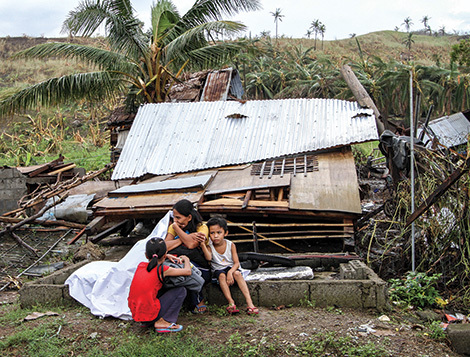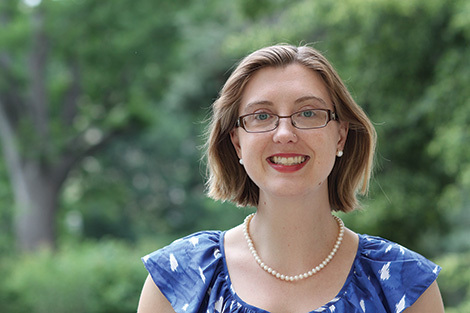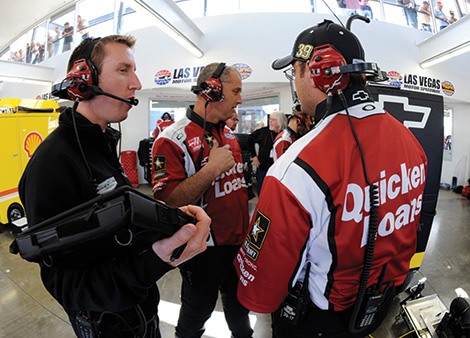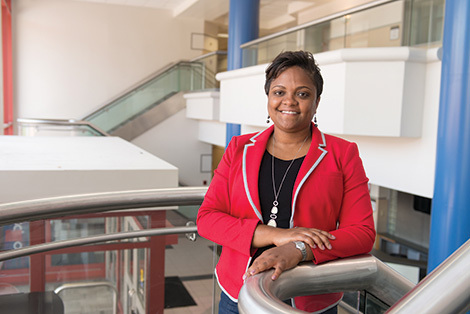CALM IN A STORM
It was the middle of the night in November 2013, just after Typhoon Haiyan struck, when Sako Narita ’04, interdisciplinary studies (international emergency health services), received an urgent phone call from Japan with a request: a disaster response team organized by Humanitarian Medical Assistance (HuMA) to help provide aid to the Philippines needed her expertise.
The call did not come as a surprise to Narita, who is currently a master’s student in UMBC’s emergency health services (EHS) department. She had prior experience providing disaster response for the 2011 earthquake and tsunami in her native Japan and a previous typhoon in the Philippines in 2012.
Narita spent ten days in the Philippines after Haiyan struck. She provided needs assessment, assisted patients, negotiated with local and international health and government organizations, set up mobile medical clinics, and did whatever she could to ensure typhoon victims received necessary care.
“Believe it or not, the people were more positive than we expected,” says Narita. “Sometimes people were already moving on – they started a new life and started building new houses. But deep inside, they still are struggling.”
One key part of Narita’s job was negotiation – a skill she has developed both in field experience and as part of her UMBC education.
The on-the-ground situation during Narita’s first mission in the Philippines in 2012 required her to negotiate with local officials to gain access to the disaster site for HuMA. During her more recent trip, she brokered a partnership with an Israeli disaster response team.
The international reputation of UMBC’s EHS department as a leader in the field helped attract Narita – a student from Japan who was interested in studying the intersection between medicine and emergency health services.
“All of my knowledge about disaster response I got at UMBC,” Narita observes.
“What makes our program different from every other program is that our focus is on that area of overlap between public health and emergency management,” explains Rick Bissell, a professor of emergency health services and the director of the EHS graduate program.
UMBC’s graduate program offers advanced training in emergency clinical response, management and public health that prepares students like Narita to meet disaster-related emergency health needs (as well as less urgent needs) in both domestic and international situations.
“We educate the whole person,” says Bruce Walz, a professor of emergency health services and the chair of the department. “What we’ve heard back from employers is that our students know how to think. They’re not just doing a protocol. They know why they’re doing that protocol, they know why they’re giving that drug and they can make those decisions in the field.”
This priority on educating students as “whole people” is evident in the work of EHS alumni and students like Narita, who is also a national registered paramedic and Maryland emergency medical technician-paramedic. The level of dedication and quality of work for which the program’s graduates are known makes them much sought after in the aftermath of disasters such as Haiyan.
“HuMA could contact me again,” Narita says, “and I hope they do.”
— Max Cole
PLANTING A SEED
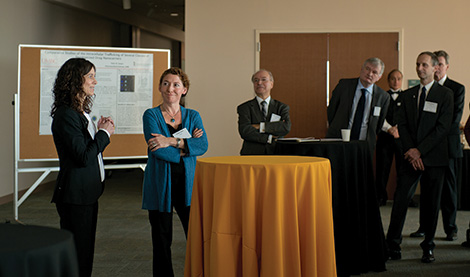
Faculty members at Maryland universities conduct a wide array of cutting-edge research – from providing relief for victims of spinal cord injury to developing new targeted methods to deliver drugs through nanotechnology.
More and more of that vital work is being done in collaborations between faculty at UMBC and the University of Maryland, Baltimore (UMB).
The latest expansion of this research partnership is the UMBC-UMB Research and Innovation Partnership Seed Grant Program that pairs primary investigators from each university to work together as a team. Successful partners are offered research funding of up to $75,000 over twelve months to pursue their collaboration.
The program’s first grant recipients were announced at a ceremony and poster session held at UMBC in February, where UMB Chief Academic and Research Officer and Senior Vice President Bruce Jarrell observed that the program represents a deepening relationship that already includes cooperation on a joint graduate school and the Institute of Marine Environmental Technology (IMET).
“These collaborations already exist,” Jarrell observed. “And we’re proud to have UMBC as a partner.”
UMBC President Freeman A. Hrabowski, III, was enthusiastic about the projects selected, which include investigations that may influence the course of research into cancer, strokes and muscle degeneration.
“The [program] is a means by which both universities can better discover each other’s strengths and needs to see how we can better collaborate,” said Hrabowski.
UMB President Jay Perman said increased partnership between the two universities is a key element of his vision: “The partnerships that UMBC and UMB have enjoyed for years are real, longstanding collaborations, and have been extremely successful, if not widely known.”
William E. Kirwan, Chancellor of the University System of Maryland, also praised the program for its “focus on cutting-edge science and health concerns” and its emphasis on interdisciplinary teamwork.
The first five teams are:
• Kathleen Hoffman, professor of mathematics (UMBC), and Asaf Keller, professor of anatomy and neurobiology (UMB), are exploring the chronic pain of patients with spinal cord injury and how computational modeling may help analyze the neurobiological changes in the central nervous system.
• Martin Schneider, professor of biochemistry and molecular biology (UMB), and Bradford E. Peercy, assistant professor of mathematics (UMBC) are combining forces to analyze a transcription factor (Foxo1) in skeletal muscle that activates genes in a pathway that leads to the breakdown of muscle protein.
• Charles Bieberich, professor of biological sciences (UMBC), and Paul Shapiro, associate professor of pharmaceutical sciences (UMB) are working on a more targeted use of a promising cancer treatment called “kinase inhibition.”
• Marie-Christine Daniel, associate professor of chemistry and biochemistry (UMBC), and Peter Swaan, professor of pharmaceutical sciences (UMB) are exploring how nanotechnology might improve the delivery of drugs.
• Tulay Adali, professor of computer science and electrical engineering (UMBC) and Kelly Westlake, assistant professor of physical therapy and rehabilitation science (UMB) are exploring how using a powerful computational tool (independent vector analysis) can better help the recovery of stroke victims.
— Richard Byrne ’86
BURGEONING BIOINFORMATICS

There are no test tubes, petri dishes or microscopes in Ivan Erill’s research lab. No chemical cabinets or safety goggles. Indeed, the room in the Biological Sciences Building where the assistant professor of biological sciences works is what scientists call a “dry lab” – a bunch of desks, computers and swivel chairs.
Erill is a computational biologist. He describes the field as “a hybrid between computer science and biology.” Bioinformatics, the sister field to computational biology, was founded by Margaret Dayhoff in the 1960s. At that time, sequencing a single gene or protein could earn you a Ph.D. But these days, “next generation” sequencing machines can output more than a billion DNA bases per day.
The DNA molecules in all living things are made up of only four building blocks called “nitrogenous bases” – nicknamed A, T, C, and G. They bond to form pairs: A always bonds with T, C always bonds with G. The sequence of the bases ultimately determines an organism’s traits.
Biologists often rely on models for their work, and computational biologists use large sets of sequence data to design models of biological systems. But all models include assumptions that don’t perfectly represent biological reality.
“Every model is wrong,” says Erill. After comparing the results of a model to experimental data, scientists “refine the model as a way to get a better approximation and confirm theories about how biology works.”
Working in this field requires an eclectic skill set. “In order to create the models you need a technical background,” explains Erill. “[But] you also need enough knowledge of the biology to understand what you are trying to model, why, and the nuances in the biological process.”
UMBC is one of the few universities that offers an undergraduate major in bioinformatics. Some of these students work in Erill’s lab, but most of his graduate students have undergraduate degrees in mathematics or computer science.
These researchers are working on exciting projects, including how the three-dimensional shape of DNA affects where proteins can bind to it. These proteins, known as transcription factors (TFs), help determine which other proteins are produced in a cell. Patrick O’Neill, a graduate student in Erill’s lab, said that these proteins are so fundamental that “whatever you’re studying, soon enough you’re going to bump into a transcription factor.”
Another project looks at the “metagenome.” It’s a concept that explores how DNA sequences in the same environment (like a cow’s gut), can regulate each other even if they are from different species (e.g. the cow and a bacterium). “Very simple systems, with simple parts, can collectively have very complex behavior,” observes O’Neill.
So what’s next for computational biology? You’ve probably heard of the genome, but probably not the “interactome.” Erill describes it as the set of all interactions between molecules in a cell. Computational biologists create 3-D images that represent all these interactions, which Erill describes as “hairy balls.”
When the field began, scientists were looking at isolated systems. But now they’re zooming out. Erill says that the amount of information “balloons super rapidly and becomes one of these hairy balls, and then the problem becomes how do you turn that into useful knowledge for our brains? How does that inform biology? That’s where the big challenge lies.”
— Sarah L. Hansen
Image credit: Andrew Garrow
Human interactome – round1 – Cytoscape
CREATE & COLLABORATE
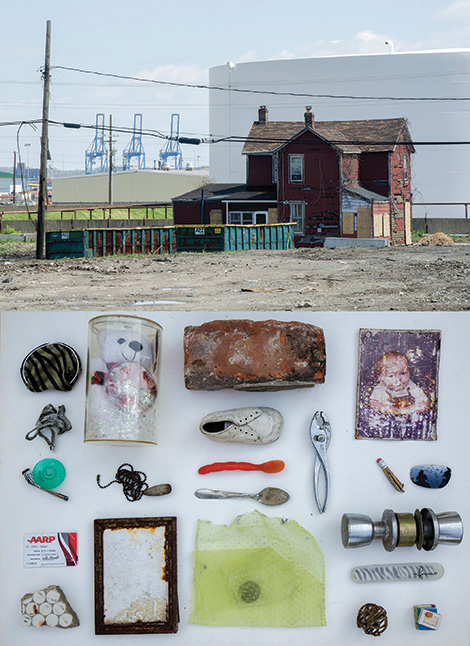
On a large screen in the Dresher Center for the Humanities, there is a diptych. At the top is the home of Jimmy and Debbie Drake, the last such structure standing in their southeast Baltimore neighborhood; below it is a collection of items left behind post-demolition. The room goes silent as students, staff and faculty lean forward in their chairs to ponder a baby shoe, an AARP membership card, the worn image of a child. But, the quiet doesn’t last long.
Behind the projector, Stephen Bradley, an associate professor of visual arts, and Nicole King, an assistant professor of American Studies, engage the audience in a discussion of their research, a digital mapping and storytelling effort surrounding the history of Baybrook – an industrial neighborhood in Baltimore.
This sort of interdisciplinary research is de rigueur at UMBC, but the venue for the gathering where Bradley and King presented their collaboration – a new “Catalyst” series of informal lunchtime discussions – is relatively new.
It springs from a campus vision that created UMBC’s year-old Center for Innovation, Research, and Creativity in the Arts, or CIRCA – the latest initiative in a concerted push by UMBC to inspire and promote inquiry and experimentation in and across the arts.
“In a very practical way, UMBC has made a commitment to the visual and performing arts to make it visible, and for the research to come into the light and be supported,” says Tim Nohe, a professor of visual arts, and director of the center.
Besides the Catalyst series, which focuses on making interdisciplinary arts research accessible to the UMBC community, CIRCA also provides multiple levels of support to faculty for their research. Young academics can find assistance in learning how to seed a project – from scouring for research dollars to finding a research partner in another discipline. CIRCA also awards small grants for research, with the potential for more in the future, Nohe says.
Nohe credits John Jeffries, dean emeritus of the College of Arts, Humanities and Social Sciences, and others with making CIRCA a reality. He adds that CIRCA also serves as another off-campus extension of the UMBC arts community in the Baltimore art scene and beyond.
“It’s important to remind them there are other players” in Baltimore, Nohe says.
As UMBC’s footprint in the arts (and research into the arts) grows, Nohe hopes CIRCA grows along with it. That means more thoughtful discussions among community members, and more opportunities to share ideas in a way that spurs new research not only among artists, but collaborators across campus. There will be chances overall for CIRCA to make an impact on the arts at UMBC.
“The level of work is incredibly high here, and it’s incredibly creative,” says Nohe. “And it’s CIRCA’s job to shine that light.”
— Jenny O’ Grady
Image credit: “Lost Fairfield,” 2010, by Stephen Bradley
Tags: Summer 2014

